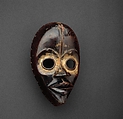Face Mask (Gunye Ge)
Not on view
The border between Cote d'Ivoire and Liberia cuts across several ethnic groups, including the Dan, Wee, Kran, and Grebo. In Dan society, dangerous immaterial forest spirits are translated into the forms of human face masks. Whether or not they are worn, such sculptures are spiritually charged. Male performers, gle-zo, experience a dream sent by the mask spirit that allows them to dance it. In performance, the masks are integrated into the hierarchical system that governs political and religious life.
Dan masks have been documented as the embodiment of at least a dozen artistic personalities. Among these are Deangle, who ventures into the village from the initiation camps to ask women for food; Tankagle and Bagle, who entertain through a range of aesthetically pleasing dances, skits, and mimes; Gunyege, whose mask is worn by a community's champion foot racers in competitions; and Bugle, who historically leads men into battle. With its wide circular ocular apertures and slightly raised rim, this mask can be identified as Gunyege. During the races held each week of the dry season in the northern savanna, a runner wearing such a mask would chase a unmasked runner. If he managed to catch him by the neck and back, he kept his mask. If not, the unmasked runner would put on his own mask and, in turn, chase another competitor. At the end of the season, the runner with the most victories was proclaimed the champion.
Once they are divorced from their performance contexts, however, mask forms are difficult to identify. Performances of Bete and Wee masks may span the careers of many generations of wearers, contributing to the increasingly sacred status of these objects. A masquerade's vitality may also be transferred from one mask form to another. Over time, any respected Dan mask may eventually be elevated to the category gunagle, the mask that represents a village quarter, or gle wa, a judicial mask.
Due to rights restrictions, this image cannot be enlarged, viewed at full screen, or downloaded.


